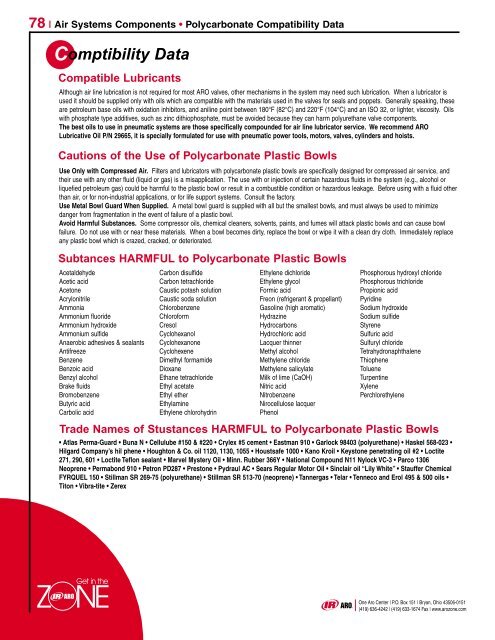Catalog: Air System Components - Fluid Power Distributor
Catalog: Air System Components - Fluid Power Distributor
Catalog: Air System Components - Fluid Power Distributor
You also want an ePaper? Increase the reach of your titles
YUMPU automatically turns print PDFs into web optimized ePapers that Google loves.
78 | <strong>Air</strong> <strong>System</strong>s <strong>Components</strong> • Polycarbonate Compatibility Data<br />
Comptibility Data<br />
Compatible Lubricants<br />
Although air line lubrication is not required for most ARO valves, other mechanisms in the system may need such lubrication. When a lubricator is<br />
used it should be supplied only with oils which are compatible with the materials used in the valves for seals and poppets. Generally speaking, these<br />
are petroleum base oils with oxidation inhibitors, and aniline point between 180°F (82°C) and 220°F (104°C) and an ISO 32, or lighter, viscosity. Oils<br />
with phosphate type additives, such as zinc dithiophosphate, must be avoided because they can harm polyurethane valve components.<br />
The best oils to use in pneumatic systems are those specifically compounded for air line lubricator service. We recommend ARO<br />
Lubricative Oil P/N 29665, it is specially formulated for use with pneumatic power tools, motors, valves, cylinders and hoists.<br />
Cautions of the Use of Polycarbonate Plastic Bowls<br />
Use Only with Compressed <strong>Air</strong>. Filters and lubricators with polycarbonate plastic bowls are specifically designed for compressed air service, and<br />
their use with any other fluid (liquid or gas) is a misapplication. The use with or injection of certain hazardous fluids in the system (e.g., alcohol or<br />
liquefied petroleum gas) could be harmful to the plastic bowl or result in a combustible condition or hazardous leakage. Before using with a fluid other<br />
than air, or for non-industrial applications, or for life support systems. Consult the factory.<br />
Use Metal Bowl Guard When Supplied. A metal bowl guard is supplied with all but the smallest bowls, and must always be used to minimize<br />
danger from fragmentation in the event of failure of a plastic bowl.<br />
Avoid Harmful Substances. Some compressor oils, chemical cleaners, solvents, paints, and fumes will attack plastic bowls and can cause bowl<br />
failure. Do not use with or near these materials. When a bowl becomes dirty, replace the bowl or wipe it with a clean dry cloth. Immediately replace<br />
any plastic bowl which is crazed, cracked, or deteriorated.<br />
Subtances HARMFUL to Polycarbonate Plastic Bowls<br />
Acetaldehyde<br />
Acetic acid<br />
Acetone<br />
Acrylonitrile<br />
Ammonia<br />
Ammonium fluoride<br />
Ammonium hydroxide<br />
Ammonium sulfide<br />
Anaerobic adhesives & sealants<br />
Antifreeze<br />
Benzene<br />
Benzoic acid<br />
Benzyl alcohol<br />
Brake fluids<br />
Bromobenzene<br />
Butyric acid<br />
Carbolic acid<br />
• Atlas Perma-Guard • Buna N • Cellulube #150 & #220 • Crylex #5 cement • Eastman 910 • Garlock 98403 (polyurethane) • Haskel 568-023 •<br />
Hilgard Company’s hil phene • Houghton & Co. oil 1120, 1130, 1055 • Houstsafe 1000 • Kano Kroil • Keystone penetrating oil #2 • Loctite<br />
271, 290, 601 • Loctite Teflon sealant • Marvel Mystery Oil • Minn. Rubber 366Y • National Compound N11 Nylock VC-3 • Parco 1306<br />
Neoprene • Permabond 910 • Petron PD287 • Prestone • Pydraul AC • Sears Regular Motor Oil • Sinclair oil “Lily White”• Stauffer Chemical<br />
FYRQUEL 150 • Stillman SR 269-75 (polyurethane) • Stillman SR 513-70 (neoprene) • Tannergas • Telar • Tenneco and Erol 495 & 500 oils •<br />
Titon • Vibra-tite • Zerex<br />
Get in the<br />
Carbon disulfide<br />
Carbon tetrachloride<br />
Caustic potash solution<br />
Caustic soda solution<br />
Chlorobenzene<br />
Chloroform<br />
Cresol<br />
Cyclohexanol<br />
Cyclohexanone<br />
Cyclohexene<br />
Dimethyl formamide<br />
Dioxane<br />
Ethane tetrachloride<br />
Ethyl acetate<br />
Ethyl ether<br />
Ethylamine<br />
Ethylene chlorohydrin<br />
Ethylene dichloride<br />
Ethylene glycol<br />
Formic acid<br />
Freon (refrigerant & propellant)<br />
Gasoline (high aromatic)<br />
Hydrazine<br />
Hydrocarbons<br />
Hydrochloric acid<br />
Lacquer thinner<br />
Methyl alcohol<br />
Methylene chloride<br />
Methylene salicylate<br />
Milk of lime (CaOH)<br />
Nitric acid<br />
Nitrobenzene<br />
Nirocellulose lacquer<br />
Phenol<br />
Phosphorous hydroxyl chloride<br />
Phosphorous trichloride<br />
Propionic acid<br />
Pyridine<br />
Sodium hydroxide<br />
Sodium sulfide<br />
Styrene<br />
Sulfuric acid<br />
Sulfuryl chloride<br />
Tetrahydronaphthalene<br />
Thiophene<br />
Toluene<br />
Turpentine<br />
Xylene<br />
Perchlorethylene<br />
Trade Names of Stustances HARMFUL to Polycarbonate Plastic Bowls<br />
One Aro Center | P.O. Box 151 | Bryan, Ohio 43506-0151<br />
(419) 636-4242 | (419) 633-1674 Fax | www.arozone.com


